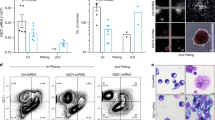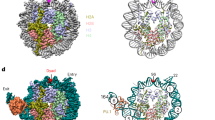Abstract
The Pbx/Exd family of homeodomain (HD) proteins contribute to the transcriptional and developmental roles of other Hox and Meis/Prep1/Hth HD proteins through heterodimer formation. E2a-Pbx1 is an oncogenic derrivative of Pbx1 produced by the t(1;19) translocation in pediatric pre-B cell acute lymphoblastic leukemia. E2a-Pbx1 heterodimerizes with Hox but not with Meis/Prep1 proteins, produces acute myeloid leukemia in mice, and blocks differentiation of cultured murine myeloid progenitors. Here, we characterize negative and positive regulatory sequences that flank the Pbx1 HD and determine their importance for myeloid immortalization by E2a-Pbx1. A 25 residue predicted α helix preceding the Pbx1 HD bound the HD and prevented both its binding to DNA and its ability to heterodimerize with Hox proteins. Addition of 39 residues N-terminal to this inhibitory helix exposed a Pbx dimerization interface that orchestrated cooperative DNA-binding of E2a-Pbx1 and all Pbx proteins as homodimers and heterdimers. Sequences inhibiting DNA-binding and mediating Pbx dimerization coincided with those reported to have nuclear export function. An additional 103 residues N-terminal to the Pbx dimerization interface restored heterodimerization with Hox and Meis1/Prep1 proteins. This negative switch domain – comprised of the inhibitory helix and N-terminal regions required for its partner-mediated derepression – was dispensable for myeloid immortalization by E2a-Pbx1. While stabilizing the heterodimer, the 310 helix C-terminal to the Pbx1 HD was also dispensable for the ability of E2a-Pbx1 to heterodimerize with Hox proteins and immortalize myeloblasts. Retention of myeloid immortalization by E2a-Pbx1 proteins lacking all Pbx1 sequences N- or C-terminal to the HD indicates that Hox proteins, or a yet undefined factor that binds the Pbx1 HD and derepresses DNA-binding by the HD, cooperate with E2a-Pbx1 in myeloid immortalization.
This is a preview of subscription content, access via your institution
Access options
Subscribe to this journal
Receive 50 print issues and online access
$259.00 per year
only $5.18 per issue
Buy this article
- Purchase on Springer Link
- Instant access to full article PDF
Prices may be subject to local taxes which are calculated during checkout






Similar content being viewed by others
References
Abu-Shaar M, Ryoo H and Mann R. . 1999 Genes Dev. 13: 935–945.
Bain G, Maandag EC, Izon DJ, Amsen D, Kruisbeek AM, Weintraub BC, Krop I, Schlissel MS, Feeney AJ, van Roon M and Murre C. . 1994 Cell 79: 885–892.
Ben-Levy R, Hooper S, Wilson R, Paterson HF and Marshall CJ. . 1998 Curr. Biol. 8: 1049–1057.
Berthelsen J, Zappavigna V, Mavilio F and Blasi F. . 1998a EMBO J. 17: 1423–1433.
Berthelsen J, Zappavigna V, Ferretti E, Mavilio F and Blasi F. . 1998b EMBO J. 17: 1434–1445.
Berthelsen J, Kilstrup-Nielsen C, Blasi F, Mavilio F and Zappavigna V. . 1999 Genes Dev. 13: 946–953.
Bischof LJ, Kagawa N, Moskow TJ, Takahashi Y, Iwamatsu A, Buchberg AM and Waterman MR. . 1998 J. Biol. Chem. 273: 7941–7948.
Carroll A, Crist W, Parmley R, Roper M, Cooper M and Finley W. . 1984 Blood 63: 721–724.
Chan SK, Jaffe L, Capovilla M, Botas J and Mann R. . 1994 Cell 78: 603–615.
Chang CP, Brocchieri L, Shen WF, Largman C and Cleary ML. . 1996 Mol. Cell Biol. 16: 1734–1745.
Chang CP, De Vivo I and Cleary ML. . 1997 Mol. Cell. Biol. 17: 81–88.
Chang CP, Jacobs Y, Nakamura T, Jenkins NA, Copeland NG and Cleary ML. . 1997 Mol. Cell. Biol. 17: 5679–5687.
De Cesare D, Palazzolo M, Berthelsen J and Blasi F. . 1997 J. Biol. Chem. 272: 23921–23929.
Dedera DA, Waller EK, Lebrun DP, Sen-Majumdar A, Stevens ME, Barsh GS and Cleary ML. . 1993 Cell 74: 833–843.
Di Rocco G, Mavilio F and Zappavigna V. . 1997 EMBO J. 16: 3644–3654.
Engel K, Kotlyarow A and Gaestel M. . 1998 EMBO J. 17: 3363–3371.
Fu X and Kamps MP. . 1997 Mol. Cell. Biol. 17: 1503–1512.
Ganchi PA, Sun SC, Green WC and Ballard DW. . 1992 Mol. Biol. Cell 12: 1339–1352.
Goudet G, Delhalle S, Biemar F, Martial JA and Peers B. . 1999 J. Biol. Chem. 274: 4067–4073.
Green NC, Rambaldi I, Teakles J and Featherstone MS. . 1998 J. Biol. Chem. 273: 13273–13279.
Grieder NC, Marty T, Hyung-Don R, Mann RS and Affolter M. . 1997 EMBO J. 16: 7402–7410.
Jacobs T, Schnabel CA and Cleary ML. . 1999 Mol. Cell. Biol. 19: 5134–5142.
Jonsen MD, Petersen JM, Xu QP and Graves BJ. . 1996 Mol. Cell. Biol. 16: 2065–2073.
Kaffman A, Rank NM, O'Neill EM, Huang LS and O'Shea EK. . 1998 Nature 396: 482–486.
Kamps MP, Murre C, Sun X and Baltimore D. . 1990 Cell 60: 547–555.
Kamps MP, Look T and Baltimore D. . 1991 Genes Dev. 5: 358–368.
Kamps MP and Baltimore D. . 1993 Mol. Cell Biol. 13: 351–357.
Kamps MP and Wright D. . 1994 Oncogene 9: 3159–3166.
Kamps MP, Wright D and Lu Q. . 1996 Oncogene 12: 19–30.
Kanno T, Kanno Y, Chen LF, Ogawa E, Kim WY and Ito Y. . 1998 Mol. Cell. Biol. 18: 2444–2454.
Kasper LH, Brindle PK, Schnabel CA, Pritchard CE, Cleary ML and van Deursen JM. . 1999 Mol. Cell. Biol. 19: 764–776.
Kim WY, Sieweke M, Ogawa E, Wee HJ, Englmeier U, Graf T and Ito Y. . 1999 EMBO J. 18: 1609–1620.
Knoepfler P and Kamps MP. . 1997 Oncogene 14: 2521–2531.
Knoepfler P, Calvo K, Chen H, Antonarakis S and Kamps MP. . 1997 Proc. Natl. Acad. Sci. USA 94: 14553–14558.
Komeili A and O'Shea EK. . 1999 Science 284: 977–980.
Krosl J, Baban S, Krosl G, Rozenfeld S, Largman C and Sauvageau G. . 1998 Oncogene 16: 3403–3412.
Leprince D, Gegonne A, Coll J, de Taisne C, Schneeberger A, Lagrou C and Stehelin D. . 1983 Nature 306: 395–397.
Lu Q, Knoepfler P, Scheele J, Wright DD and Kamps MP. . 1995 Mol. Cell. Biol. 15: 3786–3795.
Lu Q and Kamps MP. . 1996 Mol. Cell. Biol. 16: 1632–1640.
Lu Q and Kamps MP. . 1997 Oncogene 14: 75–83.
McWhirter JR, Goulding M, Weiner JA, Chun J and Murre C. . 1997 Development 124: 3221–3232.
Monica K, Galili N, Nourse J, Saltman D and Cleary ML. . 1991 Mol. Cell. Biol. 11: 6149–6157.
Monica K, LeBrun DP, Dedera DA, Brown R and Cleary ML. . 1994 Mol. Cell. Biol. 14: 8304–8314.
Neuteboom ST and Murre C. . 1997 Mol. Cell. Biol. 17: 4696–4706.
Nourse J, Mellentin JD, Galili N, Wilkinson J, Stanbridge E, Smith SD and Cleary ML. . 1990 Cell 60: 535–545.
Numata S, Kato K and Horibe K. . 1993 Leukemia 7: 1441–1444.
Pai C, Kuo T, Jaw T, Kurant E, Chen C, Bessarab D, Salzberg A and Sun H. . 1998 Genes Dev. 12: 435–446.
Passner JM, Ryoo HD, Shen L, Mann RS and Aggarwal AK. . 1999 Nature 397: 714–719.
Peers B, Sharma S, Johnson T, Kamps M and Montminy M. . 1995 Mol. Cell Biol. 15: 7091–7097.
Petersen JM, Skalicky JJ, Donaldson LW, McIntosh LP, Alber T and Graves BJ. . 1995 Science 269: 1866–1869.
Peltenburg LTC and Murre C. . 1997 Development 124: 1089–1096.
Piper DE, Batchelor AH, Chang C, Cleary ML and Wolberger C. . 1999 Cell 96: 587–597.
Pöpperl H, Bienz M, Studer M, Chan SK, Aparicio S, Brenner S, Mann RS and Krumlauf R. . 1995 Cell 81: 1031–1042.
Quong M, Massari M, Zwart R and Murre C. . 1993 Mol. Cell. Biol. 13: 792–800.
Rauskolb C, Peifer M and Wieschaus E. . 1993 Cell 74: 1101–1112.
Rauskolb C and Wieschaus E. . 1994 EMBO J. 13: 3561–3569.
Rieckhof G, Casares F, Ryoo H, Abu-Shaar M and Mann R. . 1997 Cell 91: 171–183.
Roberts VJ, Steenbergen R and Murre C. . 1993 Proc. Natl. Acad. Sci. USA 90: 7583–7588.
Roberts VJ, van Dijk MA and Murre C. . 1995 Mech. Dev. 51: 193–198.
Shen WF, Rozenfeld S, Lawrence HJ and Largman C. . 1997 J. Biol. Chem. 272: 8198–8206.
Subramaniam N, Cairns W and Okret S. . 1997 DNA Cell Biol. 16: 153–163.
Subramaniam N, Cairns W and Okret S. . 1998 J. Biol. Chem. 273: 23567–23574.
Van Dijk MA and Murre C. . 1994 Cell 78: 617–624.
Wasylyk C, Kerckaert JP and Wasylyk B. . 1992 Genes Dev. 6: 965–974.
Williams D, Look A, Melvin S, Roberson P, Dahl G, Flake T and Strass S. . 1984 Cell 36: 101–109.
Acknowledgements
We thank Martina Pasallis for excellent technical help. MP Kamps is a Leukemia Society of America Scholar. KR Calvo is supported by an NCI training grant. This work was supported by Public Health Services grant CA56876.
Author information
Authors and Affiliations
Rights and permissions
About this article
Cite this article
Calvo, K., Knoepfler, P., McGrath, S. et al. An inhibitory switch derepressed by Pbx, Hox, and Meis/Prep1 partners regulates DNA-binding by Pbx1 and E2a-Pbx1 and is dispensable for myeloid immortalization by E2a-Pbx1. Oncogene 18, 8033–8043 (1999). https://doi.org/10.1038/sj.onc.1203377
Received:
Revised:
Accepted:
Published:
Issue Date:
DOI: https://doi.org/10.1038/sj.onc.1203377
Keywords
This article is cited by
-
Oligomeric self-association contributes to E2A-PBX1-mediated oncogenesis
Scientific Reports (2019)
-
The Interacting Domains of PREP1 and p160 are Endowed with a Remarkable Structural Stability
Molecular Biotechnology (2016)
-
The role of E2A-PBX1 in leukemogenesis
Oncogene (2001)
-
HoxB8 requires its Pbx-interaction motif to block differentiation of primary myeloid progenitors and of most cell line models of myeloid differentiation
Oncogene (2001)



